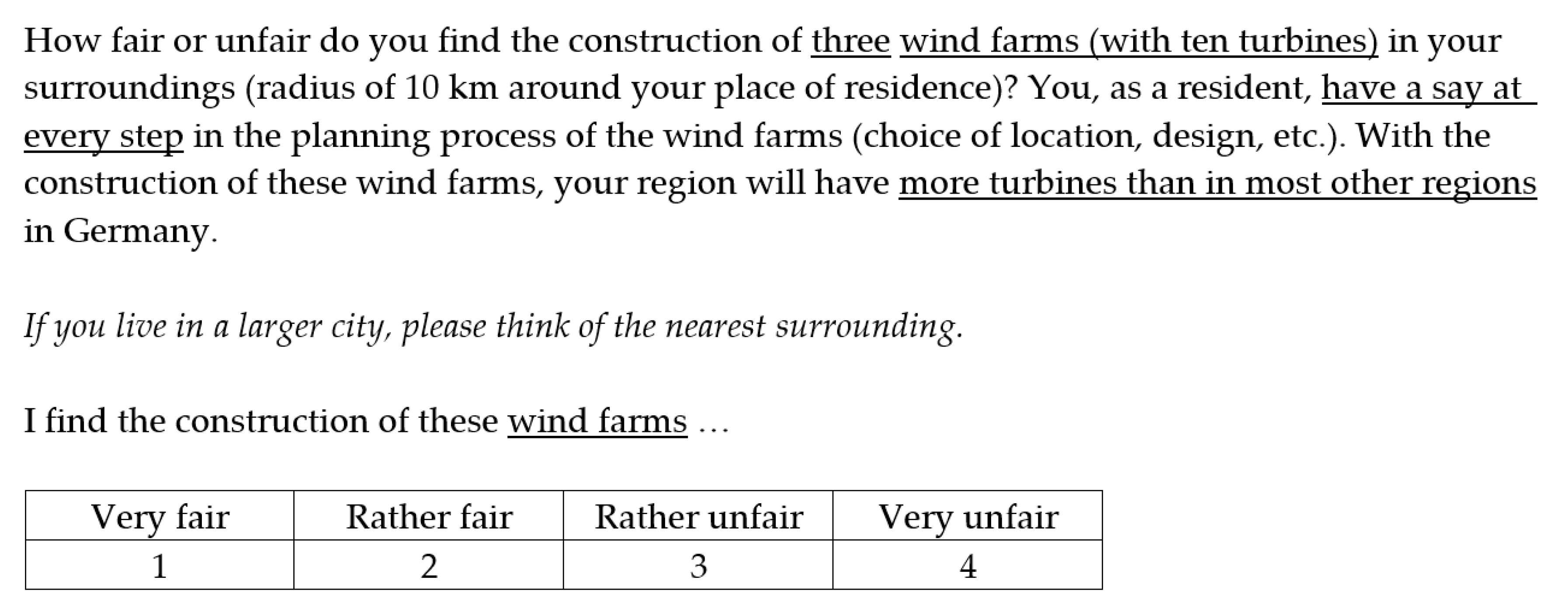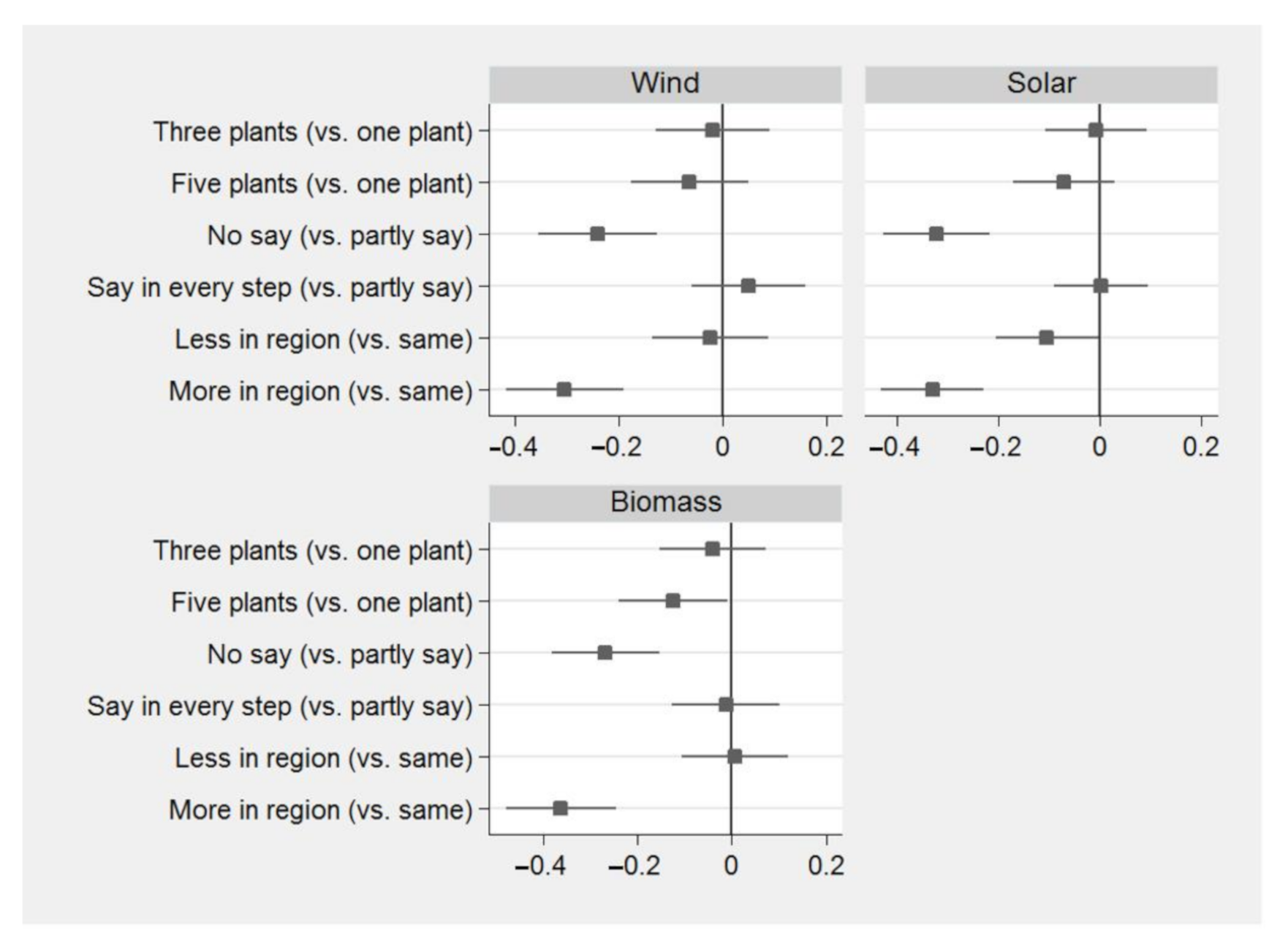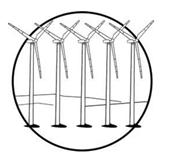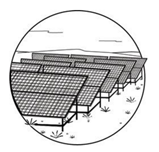Measurement of Fairness Perceptions in Energy Transition Research: A Factorial Survey Approach
Abstract
:1. Introduction
2. Factorial Survey Experimental Design and Data
2.1. Experimental Design

2.2. Data and Variables
3. Results
3.1. Overall Fairness Evaluation and Acceptance Figures
3.2. Effects of Vignette Attributes on Fairness Evaluations

3.3. Effects of Respondent Characteristics on Fairness Evaluations

4. Discussion and Conclusion
4.1. Heterogeneity of Justice Concerns
4.2. The Merits of FSEs
4.3. Desiderata for Future Research
Author Contributions
Funding
Acknowledgments
Conflicts of Interest
Appendix A
| Figure 2 | Figure 3 | |||||
|---|---|---|---|---|---|---|
| Wind | Solar | Biomass | Wind | Solar | Biomass | |
| Three plants (vs. one plants) | −0.0177 (−0.32) | −0.0127 (−0.25) | −0.0457 (−0.80) | −0.0746 (−1.67) | −0.0233 (−0.51) | −0.0601 (−1.23) |
| Five plants (vs. one plant) | −0.0660 (−1.15) | −0.0753 (−1.48) | −0.123 * (−2.08) | −0.0915 (−1.88) | −0.0540 (−1.13) | −0.117 * (−2.37) |
| No say (vs. partial say) | −0.242 *** (−4.14) | −0.319 *** (−6.00) | −0.276 *** (−4.74) | −0.239 *** (−4.99) | −0.320 *** (−6.46) | −0.264 *** (−5.21) |
| Say in every step (vs. partial say) | 0.0526 (0.95) | 0.000746 (0.02) | −0.0122 (−0.21) | 0.0636 (1.41) | −0.0184 (−0.43) | 0.00744 (0.16) |
| Less in region (vs. same) | −0.0290 (−0.51) | −0.105 * (−2.06) | 0.0101 (0.18) | −0.0422 (−0.88) | −0.113 * (−2.36) | −0.00116 (−0.02) |
| More in region (vs. same) | −0.307 *** (−5.35) | −0.334 (−6.50) | −0.360 *** (−6.09) | −0.316 *** (−6.71) | −0.360 *** (−7.69) | −0.341 *** (−6.99) |
| Acceptance of plant in vicinity | 0.459 *** (19.16) | 0.359 *** (11.40) | 0.457 *** (17.96) | |||
| Woman (vs. man) | −0.0356 (−0.89) | −0.00455 (−0.12) | −0.00282 (−0.07) | |||
| Age in years | −0.000910 (−0.60) | −0.00266 (−1.83) | −0.00359 * (−2.32) | |||
| Higher education (vs. less education) | 0.142 *** (3.39) | 0.130 ** (3.06) | 0.0823 (1.86) | |||
| Net income in Euro | 0.00000384 (0.18) | 0.0000278 (1.34) | 0.00000583 (0.26) | |||
| Medium-sized city (vs. small city) | 0.0179 (0.35) | −0.0583 (−1.19) | 0.0812 (1.53) | |||
| Large city (vs. small city) | 0.0823 (1.66) | 0.0203 (0.43) | 0.151 ** (2.92) | |||
| Place attachment | −0.0251 ** (−2.75) | −0.00297 (−0.31) | −0.00954 (−0.90) | |||
| Constant | 2.931 *** (49.33) | 3.256 *** (58.16) | 2.779 *** (43.85) | 1.879 *** (11.03) | 2.132 *** (11.92) | 1.777 *** (9.76) |
| R2 | 0.060 | 0.084 | 0.075 | 0.362 | 0.223 | 0.350 |
| n | 1051 | 1075 | 1073 | 1051 | 1075 | 1073 |
| Wind | Wind | Wind | Solar | Solar | Solar | Biomass | Biomass | Biomass | |
|---|---|---|---|---|---|---|---|---|---|
| Linear | Ordered | Binary | Linear | Ordered | Binary | Linear | Ordered | Binary | |
| Three plants (vs. one plants) | −0.0177 (−0.32) | −0.0594 (−0.42) | −0.149 (−0.89) | −0.0127 (−0.25) | −0.0137 (−0.09) | −0.0646 (−0.32) | −0.0457 (−0.80) | −0.173 (−1.24) | −0.332 * (−2.11) |
| Five plants (vs. one plant) | −0.0660 (−1.15) | −0.169 (−1.16) | −0.293 (−1.75) | −0.0753 (−1.48) | −0.213 (−1.44) | −0.292 (−1.50) | −0.123 * (−2.08) | −0.311 * (−2.18) | −0.321 * (−2.05) |
| No say (vs. partial say) | −0.242 *** (−4.14) | −0.632 *** (−4.31) | −0.764 *** (−4.58) | −0.319 *** (−6.00) | −0.928 *** (−5.90) | −1.135 *** (−5.77) | −0.276 *** (−4.74) | −0.659 *** (−4.75) | −0.667 *** (−4.30) |
| Say in every step (vs. partial say) | 0.0526 (0.95) | 0.0978 (0.68) | −0.102 (−0.59) | 0.000746 (0.02) | −0.0464 (−0.33) | −0.114 (−0.52) | −0.0122 (−0.21) | −0.00331 (−0.02) | 0.0499 (0.32) |
| Less in region (vs. same) | −0.0290 (−0.51) | −0.102 (−0.69) | −0.155 (−0.89) | −0.105 * (−2.06) | −0.380 * (−2.48) | −0.238 (−1.13) | 0.0101 (0.18) | 0.0279 (0.20) | 0.0149 (0.09) |
| More in region (vs. same) | −0.307 *** (−5.35) | −0.849 *** (−5.70) | −0.965 *** (−5.76) | −0.334 *** (−6.50) | −1.046 *** (−6.77) | −0.924 *** (−4.66) | −0.360 *** (−6.09) | −0.873 *** (−6.11) | −0.943 *** (−6.00) |
| Constant | 2.931 *** (49.33) | 1.562 *** (7.96) | 3.256 *** (58.16) | 2.454 *** (9.66) | 2.779 *** (43.85) | 0.979 *** (5.68) | |||
| Cut point 1 | −3.233 *** (−15.71) | −4.387 *** (−17.72) | −2.709 *** (−14.75) | ||||||
| Cut point 2 | −1.318 *** (−8.17) | −2.385 *** (−12.82) | −0.908 *** (−5.63) | ||||||
| Cut point 3 | 1.414 *** (8.91) | 0.590 *** (3.58) | 1.919 *** (10.91) | ||||||
| R2/Pseudo R2 | 0.060 | 0.0289 | 0.0513 | 0.084 | 0.0427 | 0.0671 | 0.075 | 0.0339 | 0.0566 |
| n | 1051 | 1051 | 1051 | 1075 | 1075 | 1075 | 1073 | 1073 | 1073 |
References
- Sovacool, B.K.; Heffron, R.J.; McCauley, D.; Goldthau, A. Energy decisions reframed as justice and ethical concerns. Nat. Energy 2016, 1, 16024. [Google Scholar] [CrossRef] [Green Version]
- Wolsink, M. Wind Power wind power: Basic Challenge Concerning Social Acceptance wind power social acceptance. In RENEWABLE Energy Systems: 3 Volumes; Kaltschmitt, M., Ed.; Springer: New York, NY, USA, 2013; ISBN 978-1-4614-5819-7. [Google Scholar]
- Jenkins, K.; McCauley, D.; Heffron, R.; Stephan, H.; Rehner, R. Energy justice: A conceptual review. Energy Res. Soc. Sci. 2016, 11, 174–182. [Google Scholar] [CrossRef] [Green Version]
- Perlaviciute, G.; Steg, L. Contextual and psychological factors shaping evaluations and acceptability of energy alternatives: Integrated review and research agenda. Renew. Sustain. Energy Rev. 2014, 35, 361–381. [Google Scholar] [CrossRef]
- Langer, K.; Decker, T.; Menrad, K. Public participation in wind energy projects located in Germany: Which form of participation is the key to acceptance? Renew. Energy 2017, 112, 63–73. [Google Scholar] [CrossRef]
- Lienhoop, N. Acceptance of wind energy and the role of financial and procedural participation: An investigation with focus groups and choice experiments. Energy Policy 2018, 118, 97–105. [Google Scholar] [CrossRef]
- Walker, C.; Baxter, J. “It’s easy to throw rocks at a corporation”: Wind energy development and distributive justice in Canada. J. Environ. Policy Plan. 2017, 19, 754–768. [Google Scholar] [CrossRef]
- Walker, B.J.A.; Russel, D.; Kurz, T. Community Benefits or Community Bribes? An Experimental Analysis of Strategies for Managing Community Perceptions of Bribery Surrounding the Siting of Renewable Energy Projects. Environ. Behav. 2016, 49, 59–83. [Google Scholar] [CrossRef] [Green Version]
- Wüstenhagen, R.; Wolsink, M.; Bürer, M.J. Social acceptance of renewable energy innovation: An introduction to the concept. Energy Policy 2007, 35, 2683–2691. [Google Scholar] [CrossRef] [Green Version]
- Liebe, U.; Preisendörfer, P.; Bruderer Enzler, H. The social acceptance of airport expansion scenarios: A factorial survey experiment. Transp. Res. Part D Transp. Environ. 2020, 84, 102363. [Google Scholar] [CrossRef]
- Baxter, J. Energy justice: Participation promotes acceptance. Nat. Energy 2017, 2, 17128. [Google Scholar] [CrossRef]
- Schlosberg, D. Defining Environmental Justice. Theories, Movements, and Nature; Oxford University Press: Oxford, UK, 2007; ISBN 9780199286294. [Google Scholar]
- Fuller, S.; McCauley, D. Framing energy justice: Perspectives from activism and advocacy. Energy Res. Soc. Sci. 2016, 11, 1–8. [Google Scholar] [CrossRef]
- Liu, F. Environmental Justice Analysis. Theories, Methods, and Practice; CRC Press: Boca Raton, FL, USA, 2001; ISBN 1566704030. [Google Scholar]
- Miller, D. Distributive Justice: What the People Think. Ethics 1992, 102, 555–593. [Google Scholar] [CrossRef]
- Miller, D. Principles of Social Justice; Harvard Univ. Press: Cambridge, MA, USA, 1999; ISBN 0-674-70628-5. [Google Scholar]
- Sandel, M.J. Justice. What’s the Right Thing to Do? Penguin Books: London, UK, 2010; ISBN 9780141041339. [Google Scholar]
- Auspurg, K.; Hinz, T. Factorial Survey Experiments; Sage: Los Angeles, CA, USA, 2015; ISBN 978-1-4522-7418-8. [Google Scholar]
- Liebig, S.; Sauer, C.; Friedhoff, S. Using Factorial Surveys to Study Justice Perceptions: Five Methodological Problems of Attitudinal Justice Research. Soc. Just. Res. 2015, 28, 415–434. [Google Scholar] [CrossRef] [Green Version]
- Rossi, P.H. Vignette analysis: Uncovering the normative structure of complex judgements. In Qualitative and Quantitative Social Research: Papers in Honor of Paul F. Lazarsfeld; Merton, R.K., Coleman, J.S., Rossi, P.H., Eds.; Free Press: New York, NY, USA, 1979; ISBN 0029209307. [Google Scholar]
- Jasso, G.; Opp, K.-D. Probing the character of norms: A factorial survey analysis of the norms of political action. Am. Sociol. Rev. 1997, 62, 947–964. [Google Scholar] [CrossRef]
- Jasso, G.; Rossi, P.H. Distributive Justice and Earned Income. Am. Sociol. Rev. 1977, 42, 639. [Google Scholar] [CrossRef]
- Wallander, L. 25 years of factorial surveys in sociology: A review. Soc. Sci. Res. 2009, 38, 505–520. [Google Scholar] [CrossRef]
- Auspurg, K.; Hinz, T.; Sauer, C.; Liebig, S. The Factorial Survey as Method for Measuring Sensitive Issues. In Improving Survey Methods: Lessons from Recent Research; Engel, U., Jann, B., Lynn, P., Scherpenzeel, A.C., Sturgis, P., Eds.; Routledge: New York, NY, USA, 2015; ISBN 9780415836258. [Google Scholar]
- Dimitropoulos, A.; Kontoleon, A. Assessing the determinants of local acceptability of wind-farm investment: A choice experiment in the Greek Aegean Islands. Energy Policy 2009, 37, 1842–1854. [Google Scholar] [CrossRef]
- García, J.H.; Cherry, T.L.; Kallbekken, S.; Torvanger, A. Willingness to accept local wind energy development: Does the compensation mechanism matter? Energy Policy 2016, 99, 165–173. [Google Scholar] [CrossRef]
- Liebe, U.; Bartczak, A.; Meyerhoff, J. A turbine is not only a turbine: The role of social context and fairness characteristics for the local acceptance of wind power. Energy Policy 2017, 107, 300–308. [Google Scholar] [CrossRef] [Green Version]
- Walter, G.; Gutscher, H. Generelle Befürwortung von Windkraftanlagen vor Ort vs. Befürwortung spezifischer Windkraftprojekte: Der Einfluss von Projekt- und Verfahrensparametern. Umweltpsychologie 2013, 17, 124–144. [Google Scholar]
- Liebe, U.; Dobers, G.M. Decomposing public support for energy policy: What drives acceptance of and intentions to protest against renewable energy expansion in Germany? Energy Res. Soc. Sci. 2019, 47, 247–260. [Google Scholar] [CrossRef] [Green Version]
- American Association for Public Opinion Research (AAPOR). Standard Definitions: Final Dispositions of Case Codes and Outcome Rates for Surveys. 2016. Available online: https://www.aapor.org/AAPOR_Main/media/publications/Standard-Definitions20169theditionfinal.pdf (accessed on 28 March 2018).
- Federal Statistical Office of Germany. Statistisches Jahrbuch Deutschland und Internationales, Red.-Schluss: 01. August 2015; Federal Statistical Office of Germany: Wiesbaden, Germany, 2015; ISBN 978-3-8246-1037-2. [Google Scholar]
- Wolsink, M. Planning of renewables schemes: Deliberative and fair decision-making on landscape issues instead of reproachful accusations of non-cooperation. Energy Policy 2007, 35, 2692–2704. [Google Scholar] [CrossRef]
- Wolsink, M. Wind power implementation: The nature of public attitudes: Equity and fairness instead of ‘backyard motives’. Renew. Sustain. Energy Rev. 2007, 11, 1188–1207. [Google Scholar] [CrossRef]
- Drechsler, M.; Egerer, J.; Lange, M.; Masurowski, F.; Meyerhoff, J.; Oehlmann, M. Efficient and equitable spatial allocation of renewable power plants at the country scale. Nat. Energy 2017, 2, 289. [Google Scholar] [CrossRef]
- Kollmuss, A.; Agyeman, J. Mind the Gap: Why do people act environmentally and what are the barriers to pro-environmental behavior? Environ. Educ. Res. 2002, 8, 239–260. [Google Scholar] [CrossRef] [Green Version]
- Agentur für Erneuerbare Energien (AEE). Klares Bekenntnis der Deutschen Bevölkerung zu Erneuerbaren Energien. Available online: https://www.unendlich-viel-energie.de/themen/akzeptanz-erneuerbarer/akzeptanz-umfrage/klares-bekenntnis-der-deutschen-bevoelkerung-zu-erneuerbaren-energien (accessed on 21 September 2020).
- Mutz, D.C. Population-Based Survey Experiments; Princeton Univ. Press: Princeton, NJ, USA, 2011; ISBN 9780691144528. [Google Scholar]
- Louviere, J.J.; Hensher, D.A.; Swait, J.; Adamowicz, W.L. Stated Choice Methods. Analysis and Applications; Cambridge University Press: Cambridge, UK, 2010; ISBN 9780521782753. [Google Scholar]
- Sauer, C.G.; Auspurg, K.; Hinz, T.; Liebig, S. The application of factorial surveys in general population samples: The effects of respondent age and education on response times and response consistency. Surv. Res. Methods 2011, 5, 89–102. [Google Scholar]
- Auspurg, K.; Jäckle, A. First Equals Most Important? Order Effects in Vignette-Based Measurement. Sociol. Methods Res. 2015, 46, 490–539. [Google Scholar] [CrossRef] [Green Version]
- Liebe, U.; Moumouni, I.M.; Bigler, C.; Ingabire, C.; Bieri, S. Using Factorial Survey Experiments to Measure Attitudes, Social Norms, and Fairness Concerns in Developing Countries. Sociol. Methods Res. 2017, 43, 1–32. [Google Scholar] [CrossRef] [Green Version]
 |  |  |
| Wind Energy refers to electricity generation with single wind turbines and wind farms onshore only. | Solar Energy refers exclusively to the production of electricity with photovoltaic systems in the open landscape, i.e., solar fields. | Biomass refers to the production of biogas and its electricity and includes both the biogas plant and the cultivation of the required biomass (such as corn). |
| Plant Type | Very Unfair (Strongly Oppose) (1) | Rather Unfair (Somewhat Oppose) (2) | Rather Fair (Somewhat Support) (3) | Very Fair (Strongly Support) (4) | Mean (SD) |
|---|---|---|---|---|---|
| Wind (n = 1051) | 7% (8%) | 26% (19%) | 54% (47%) | 13% (26%) | 2.73 (0.78) (2.91 (0.88)) |
| Solar (n = 1075) | 3% (2%) | 16% (9%) | 60% (50%) | 21% (39%) | 2.97 (0.71) (3.26 (0.70)) |
| Biomass (n = 1073) | 13% (15%) | 31% (34%) | 48% (41%) | 8% (10%) | 2.51 (0.81) (2.46 (0.87)) |
| Problems of Empirical Research | Advantages of Using FSEs |
|---|---|
| Single-item measures lack context-information on different energy-related attributes and might prompt certain answers, such as overstating the importance of an attribute. | FSEs consider several energy-related attributes, e.g., regarding renewable energy power plants and hence include more context information. Respondents have to make trade-offs. This should make prompting less likely. |
| Uncovering the relative importance of factors relevant for justice evaluations regarding energy-related issues | Based on a multifactorial design and trade-offs between justice attributes/factor, the effect/importance of each factor for justice evaluations can be determined. |
| Justice as a normative concept might be prone to socially desirable response behavior, e.g., overstating support for renewable energy production | By presenting several factors at the same time, socially desirable responses are less likely. Respondents need to make trade-offs between attributes. |
| Causal effects, e.g., regarding renewable energy power plant attributes on fairness evaluations, cannot be identified. | By randomly varying vignette attributes causal effects can be estimated. |
© 2020 by the authors. Licensee MDPI, Basel, Switzerland. This article is an open access article distributed under the terms and conditions of the Creative Commons Attribution (CC BY) license (http://creativecommons.org/licenses/by/4.0/).
Share and Cite
Liebe, U.; Dobers, G.M. Measurement of Fairness Perceptions in Energy Transition Research: A Factorial Survey Approach. Sustainability 2020, 12, 8084. https://doi.org/10.3390/su12198084
Liebe U, Dobers GM. Measurement of Fairness Perceptions in Energy Transition Research: A Factorial Survey Approach. Sustainability. 2020; 12(19):8084. https://doi.org/10.3390/su12198084
Chicago/Turabian StyleLiebe, Ulf, and Geesche M. Dobers. 2020. "Measurement of Fairness Perceptions in Energy Transition Research: A Factorial Survey Approach" Sustainability 12, no. 19: 8084. https://doi.org/10.3390/su12198084




